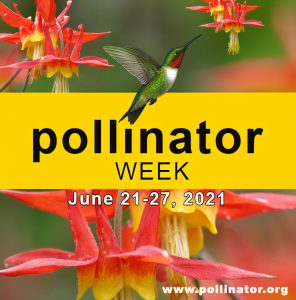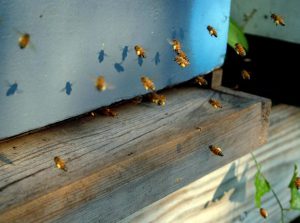 The United States Environmental Protection Agency (EPA) states that when used according to the label, pesticides “Do not cause an unreasonable risk of harm to people or the environment”. All too often it is believed that pollinators (particularly honey bees) and pesticides do not mix. However, we have the EPA saying that if used according to the label, the environment should be protected, so which is it? Pesticide labels and pesticide applicators increasingly have responsibility for ensuring pollinator protection. Let’s look at how a “Bee Box” can be used to protect the “Beehive”.
The United States Environmental Protection Agency (EPA) states that when used according to the label, pesticides “Do not cause an unreasonable risk of harm to people or the environment”. All too often it is believed that pollinators (particularly honey bees) and pesticides do not mix. However, we have the EPA saying that if used according to the label, the environment should be protected, so which is it? Pesticide labels and pesticide applicators increasingly have responsibility for ensuring pollinator protection. Let’s look at how a “Bee Box” can be used to protect the “Beehive”.
EPA and Pesticide Labels
The first part of the EPA’s statement about pesticide safety is “When used according to the label”, implying that those using pesticides know the label. Notice it does not say must memorize the label, or must attend a degree earning program, simply that a product needs to be USED according to that label. At the UF/IFAS Pesticide Information Office (PIO) we stress to ALWAYS read the label before you buy and before you USE a pesticide…every time. These labels have important safety information, for the user AND the environment, as well as information about when and how to use a product effectively.
Although it can seem difficult to protect pollinators from pesticides, it is possible. Proper training, proper integrated pest management (IPM) plans, and READING the label can all help. The EPA has begun to include the “Bee Box” language on labels (Figure 1.), to help further protect pollinator species. This box gives important guidance, rules, and suggestions for maximizing pollinator protection. Beyond being important for helping to protect the environment, these boxes can be crucial for agricultural production. Pollinators, in particular honey bees, are an integral part of growing food, so protecting them makes good business sense as well.

Licensing and IPM
Furthermore, in partnership with the Florida Department of Agriculture and Consumer Services (FDACS) the PIO seeks to ensure that in Florida, all pesticide applicators are licensed applicators. This means they (1) must initially pass a test about pesticides and (2) recertify their license by attending training and educational classes or repassing the exam. This helps to create a sense of professionalism and responsibility that can help with messaging like “pollinator protection”.
In addition, the PIO always stresses to licensed and unlicensed applicators alike, that using an IPM approach is best. The PIO stresses using ALL appropriate tools at the right time in the right way. All management options have pros and cons, so they must ALL be thought about before use. For example, using a mower to destroy pollinator plants can potentially do as much damage as a pesticide can, so right tool, right place, right time is crucial.

Recommendations on Homemade Pest Products
The internet is full of “homemade” pest control products or “home remedies” for pests, but these may be no safer to pollinators than pesticides. Additionally, the use of these “homemade” products might be illegal or ineffective. For more information about the legality of these products, visit https://edis.ifas.ufl.edu/publication/pi288, and for more information about some of the myths surrounding these products, visit https://gardeningsolutions.ifas.ufl.edu/care/pests-and-diseases/pests/management/soaps-detergents-and-pest-management.html.

Teaming Up
It’s not just agriculture and homeowners that have implemented protections for pollinators, mosquito control programs have also enhanced their efforts to protect bees. This can be achieved by primarily spraying for mosquitos later at night when skeeters are active, and bees are harboring/resting. Additionally, some municipal programs have done extensive outreach to professional and hobby beekeepers. They have detailed maps of places to possibly avoid spraying and communicate directly with these groups on the timing of the spray. This allows beekeepers to cover or otherwise protect their hives. For more information on mosquito control and beekeepers, visit https://edis.ifas.ufl.edu/pdf/IN/IN81300.pdf.
Another great way to help protect pollinators is to educate yourself. Knowing pollinator behavior, habitat, and using that to help avoid unnecessary exposure to pesticides is crucial. What better resource than the UF/IFAS Honey Bee Lab…I am glad we could cross pollinate on this blog!

It is true that pesticides can pose a risk to pollinators, but they certainly don’t have to. Yes, the Bee Advisory Box on a pesticide label can protect the beehive. Proper training, licensing, IPM practices, communication, and reading the label can all combine to help protect our pollinators. In the words of Elizabeth Lawrence “The hum of bees is the voice of the garden”, are we willing to hear them sing?
Additional Resources
Pesticide Information Office Blog: http://blogs.ifas.ufl.edu/pesticideinformation/
EDIS Publications: https://edis.ifas.ufl.edu/entity/unit/pesticide_information_office
Minimizing Honey Bee Exposure to Pesticides: https://edis.ifas.ufl.edu/publication/in1027
 This blog was written by Dr. Brett Bultemeier, Extension Assistant Professor, at the Pesticide Information Office. Dr. Brett Bultemeier Bio
This blog was written by Dr. Brett Bultemeier, Extension Assistant Professor, at the Pesticide Information Office. Dr. Brett Bultemeier Bio
In honor of National Pollinator Week, the UF Honey Bee Research and Extension Laboratory (HBREL) and the UF/IFAS Pesticide Information Office (PIO) have “cross-pollinated” to write guest posts on each other’s blogs to share research & recommendations. Be sure to read both blogs and join Dr. Brett Bultemeier (PIO Blog), Amy Vu (HBREL), Sylvia Willis (Extension Suwannee County), and Dr. Jamie Ellis (HBREL) for a multifaceted look at pollinator-friendly pesticide practices.
Pesticide Info Office Subscribe
Honey Bee Research and Extension Lab Subscribe
 0
0

